THE GAMES & ESSENTIAL RESOURCES
The Mathematics Pentathlon® Program is organized by Grade Level into 4 Divisions. Within each Division there are 5 Problem-Solving Games and related Resources that deal with a broad spectrum of mathematical thought. Division I was designed for Grades K-1, Division II for Grades 2-3, Division III for Grades 4-5, and Division IV for Grades 6-7.
To share this information with your faculty or parents,
download this Division or all Divisions Description Sheets
Game Description Sheet – Division I (K – 1)
Game Description Sheets – Div I, II, III & IV (K – 7)
THE GAMES
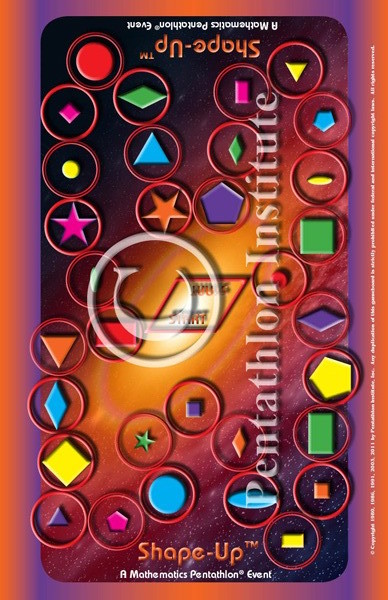 SHAPE-UP™
SHAPE-UP™
The game of Shape-Up integrates fact families with geometric shape recognition, attributes, algebraic thinking, spatial visualization, and directionality. The former two abilities relate to the goal of Shape-Up. The Shape-Up gameboard is comprised of a connected network of circles that each contain a large or small version of a geometric shape. There are eight different shapes that are rotated and colored in different ways. To win the game, students are to position one of their chips on the small version and the other chip on the large version of the same shape. What enrichens this task is that in order to win students are to focus on the attributes of shape and size and disregard the rotation and color of the shape. Chip movement is based on the roll of a die. Students choose to move one or both of their chips up or down on either side of the gameboard. Strategic play is based on using combinatorics and fact families effectively to determine better options.
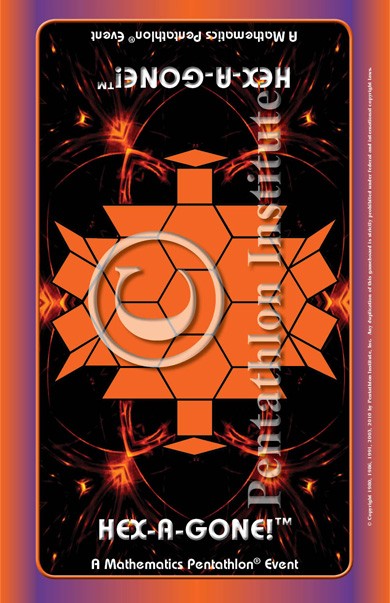 HEX-A-GONE!™
HEX-A-GONE!™
The Hex-A-Gone gameboard is comprised of connected hexagons, trapezoids, rhombi, and squares that students cover using pattern block shapes (triangles, two types of rhombi, trapezoids, squares, and hexagons). Students may use one or more blocks to fill a geometric region. For each turn, students choose one, two, or three pattern blocks in an attempt to be the last player to place a block on the board (the goal). A limited number of blocks in the bank and available spaces on the gameboard motivate students to carefully observe and analyze their options. A wide array of mathematical skills are enhanced by playing this game including spatial visualization, estimation, measurement, fractions, algebraic thinking, and deductive and inductive thought.
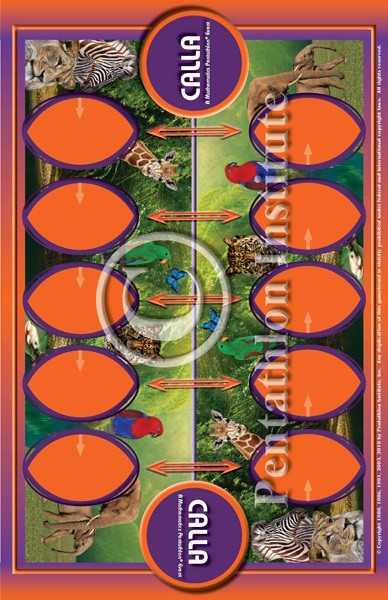 CALLA™
CALLA™
Number sense, deductive thinking, directionality, and one-to-one correspondence are developed in this challenging game that is varied from the many ancient African and Asian counting games. In this strategy game students distribute centimeter cubes around the gameboard to plan for free turns and captures that result in acquiring the greater number of cubes in their “Calla” (the goal).
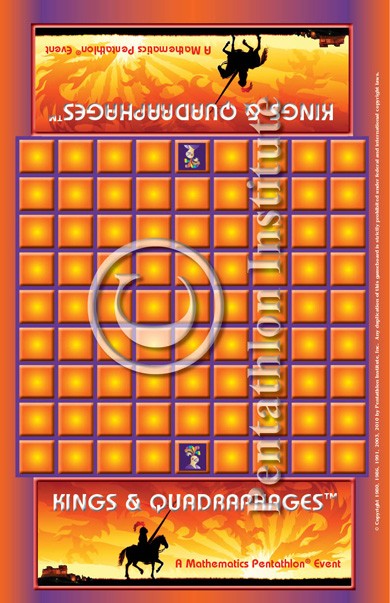 KINGS & QUADRAPHAGES™
KINGS & QUADRAPHAGES™
Horizontal, vertical, and diagonal movement, that is the basis of many mathematics/science concepts, is practiced in this simple, but challenging entrapment game. In addition, students experience a dynamic use of counting skills while exploring deductive thinking and the topology of open and closed regions. Students take turns placing a chip (referred to as a square-eating Quadraphage) on a grid-type gameboard and moving their pawn (the King) to entrap the opposing King.
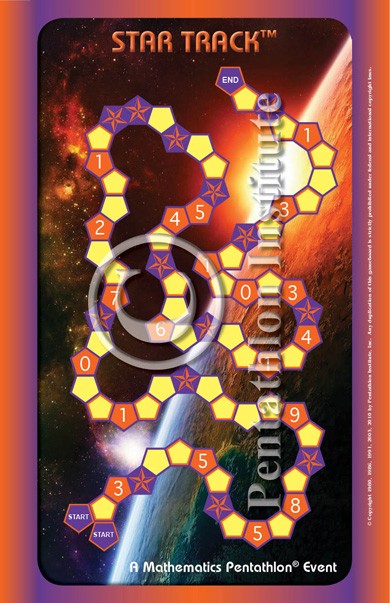 STAR TRACK™
STAR TRACK™
Number sense, inequality, addition, measurement, mapping, and decision making are experienced in this game that uses connected chain links. Students take turns selecting two chain links of various lengths from a bucket and deciding which is the better choice of the two chains. While the chain length determines how many spaces they will move on the gameboard, numeral and pentagram landings, as well as a bump rule, help students consider that bigger is not always the better choice.
THE ESSENTIAL RESOURCES

The Rule Manual for Mathematics Pentathlon Problem Solving Games Division I (Grades K-1) is a Full-Color publication that provides the Official Rules for each of the 5 Mathematics Pentathlon Games including: Background/History of the Game, Materials, Goal, How to Start the Game, Underlying Math/Science, Basic Rules, and Game Specific Tournament Rules. This detailed Manual also illustrates and describes the recommended Team Grouping for Cooperative Learning and Good Sportsmanship. In addition, a detailed Introduction defines Active Problem Solving and the many critical characteristics and philosophy of the Math Pentathlon Program. A Math Content & Standards Chart for the entire Math Pentathlon Program is outlined on the Inside Back Cover.
The Guide for Teaching and Sequencing the Mathematics Pentathlon Program Division I (Grades K-1) is a Full-Color step-by-step Teaching Guide that coordinates the Program’s three key resources: the Games and Rule Manual, the Adventures in Problem Solving Book I, and the Investigation Exercises Binder I. Organized into Monthly Lesson Plans each Guide outlines four lessons per month for weekly implementation. Each lesson describes necessary materials, approximate lesson time, resources with corresponding page numbers, and a summary of each activity with related illustrations.
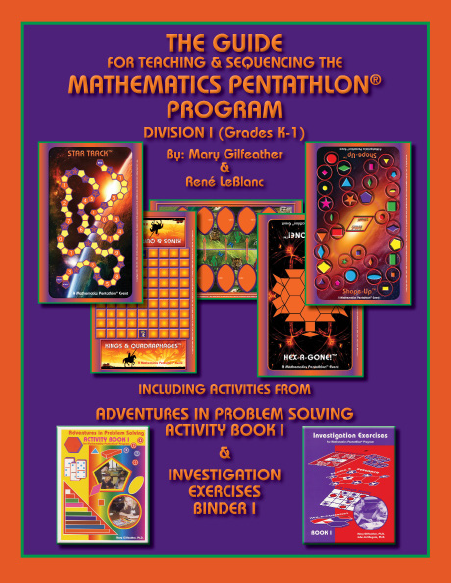
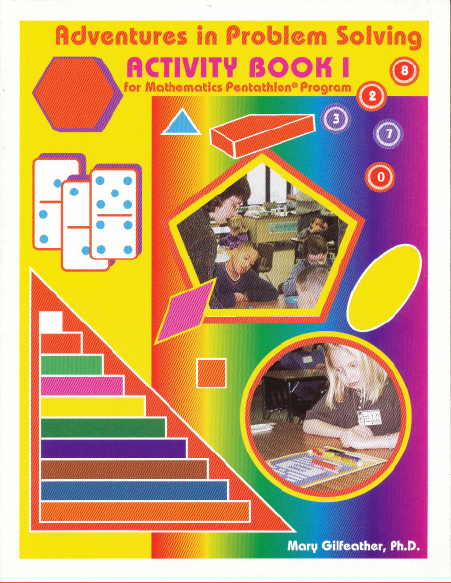
Adventures in Problem Solving Activity Book I (Grades K-3) links the Mathematics Pentathlon® series of games with the mathematics curriculum. The numerous activities and projects described in this book guide teachers/coaches to explore with their students important geometric, numerical, and scientific relationships. This publication also helps teachers to coordinate the games with mathematics content/process objectives. In addition, many introductory activities are described that develop prerequisite skills for being successful in playing the Mathematics Pentathlon® games and developing related problem-solving strategies. Both the Mathematics Pentathlon® Hames and Adventures in Problem Solving Book I activities make use of a wide variety of concrete and pictorial models that help students understand and remember important mathematical concepts.
Investigation Exercises Book I (Grades K-3) is the assessment resource for the Mathematics Pentathlon® Program. For many years educational leaders have advocated the use of assessment instruments that go beyond the minimal expectancies of standardized testing procedures. Such conventional instruments evaluate students’ ability to memorize information in unrelated situations. When teachers “teach to the test” students often use only short-term memory tactics to cope. The Mathematics Pentathlon® Games require a dynamic form of thinking that cannot be assessed with conventional instruments. Investigation Exercises Book I complements the Mathematics Pentathlon® games and Adventures in Problem Solving activities by providing numerous nonconventional paper-pencil ideas for assessing students’ understanding of mathematical relationships/skills that directly relate to the games/activities. This publication also encourages students to critically examine various game-playing options and choose strategic moves.
